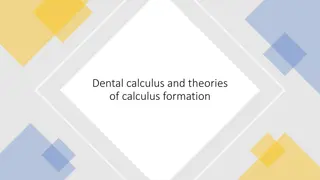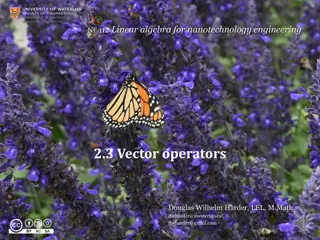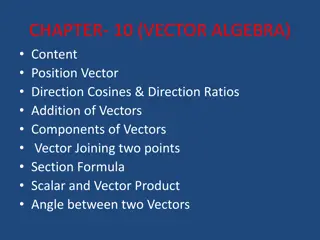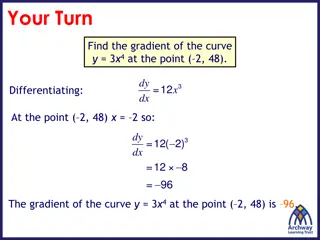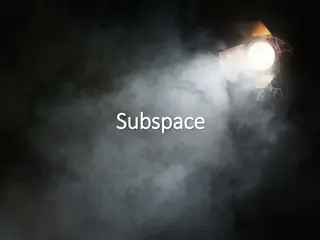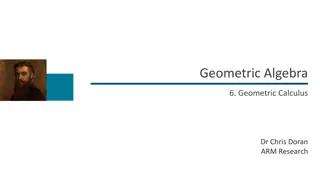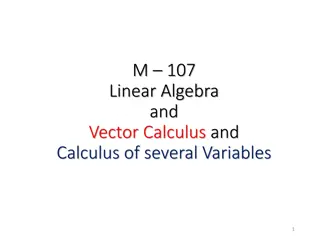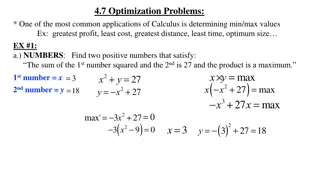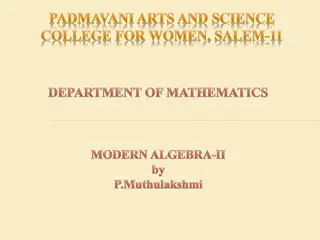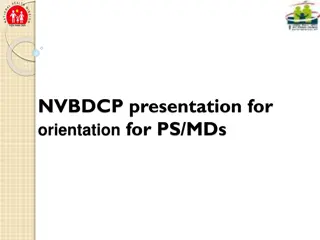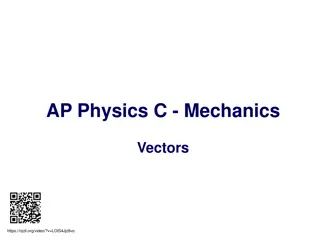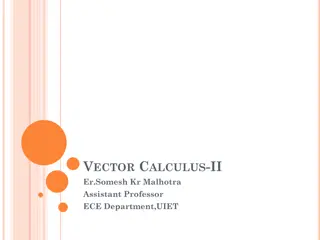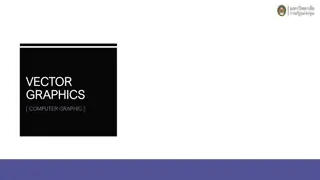Overview of Vector Calculus for ECE 3317 Course
This overview provides a brief explanation of vector calculus concepts essential for the ECE 3317 course on Applied Electromagnetic Waves. It covers del operator, gradient, divergence, curl, vector Laplacian, vector identities, and their applications in electromagnetic field theory.
Download Presentation

Please find below an Image/Link to download the presentation.
The content on the website is provided AS IS for your information and personal use only. It may not be sold, licensed, or shared on other websites without obtaining consent from the author.If you encounter any issues during the download, it is possible that the publisher has removed the file from their server.
You are allowed to download the files provided on this website for personal or commercial use, subject to the condition that they are used lawfully. All files are the property of their respective owners.
The content on the website is provided AS IS for your information and personal use only. It may not be sold, licensed, or shared on other websites without obtaining consent from the author.
E N D
Presentation Transcript
ECE 3317 Applied Electromagnetic Waves Prof. David R. Jackson Fall 2023 Notes 3 Review of Vector Calculus Adapted from notes by Prof. Stuart A. Long 1
Overview Here we present a brief overview of vector calculus. A much more thorough discussion of vector calculus may be found in the class notes for ECE 3318: http://courses.egr.uh.edu/ECE/ECE3318 Notes 13: Divergence Notes 17: Curl Notes 19: Gradient and Laplacian Please also see the textbooks and the following supplementary books (on reserve in the Library): H. M. Schey, Div, Grad, Curl, and All That: an Informal Text on Vector Calculus, 2nd Ed., W. W. Norton and Company, 1992. M. R. Spiegel, Schaum s Outline on Vector Analysis, McGraw-Hill, 1959. 2
Del Operator + + x y z This is an operator *. x y z = + + x y z Gradient (Vector) x y z 2 2 2 ( ) = = + + 2 Laplacian (Scalar) 2 2 2 x y z *An operator is something that operates on a function to return another function. 3
Del Operator (cont.) + + x y z x y z = + + xA yA zA A Vector A: x y z A y A x A z y = + + x A Divergence z (Scalar) A z A x A y A z A x A y = + + y y x y z A z x z x Curl (Please see the next slide for more details.) (Vector) Note: Results for cylindrical and spherical coordinates are given in the back of your books. 4
Del Operator (cont.) + + x y z x y z = + + xA yA zA A x y z A few more details about calculating the divergence and the curl: A y A x A z ( ) y = + + + + = + + x y x A y A z z A x A z x y z x y z ( ) = + + + + x y x A y A z z A A x y z x y z x y z = x y z A A A x y z A z A x A z A y A y A x y y = + x y z x x z z 5
Vector Identities Two fundamental zero identities: ( ) = 0 A ( ) = 0 Note: It is usually easiest to prove vector identities by expanding both sides in rectangular coordinates, though any coordinate system can be used. 6
Vector Identities (cont.) Another useful identity: ( ) ( ) ( ) A B = B A A B This will be useful in the derivation of the Poynting theorem. 7
Vector Laplacian The vector Laplacian of a vector function is a vector function. ( ) ( ) 2A A A The vector Laplacian is very useful for deriving the vector Helmholtz equation (the fundamental differential equation that the vector electric and magnetic fields obey in free space). This will be done later. + = 2 2 0 E H k E k H + = 2 2 0 8
Vector Laplacian (cont.) In rectangular coordinates, the vector Laplacian has a very nice property: ( ) ( ) ( ) + + 2 2 2 2 y z A= x A A A x y z This identity is a key property that will help us reduce the vector Helmholtz equation to the scalar Helmholtz equation, which the components of the fields satisfy in rectangular coordinates. + + = = 2 2 0 E k E x x 2 2 0 E k E y y + = 2 2 0 E k E z z 9
Gradient Physical Property ( ) ( ) r + = + + d r dr dx dy dz (from calculus) x y z ( ) ( ) ( ) = + + + + = x y x dx y dy z z dz dr x y z d d dr dr d = = d = d dr ( ) d d + r dr dr r = The gradient gives us the directional derivative , which tells us the rate of change in a function as we march in a certain direction . 10
Gradient (cont.) Rectangular = + + x y z x y z Cylindrical 1 = + + z z Spherical 1 r 1 = + + r sin r r 11
Divergence Physical Property z 1 V = A ndS Lim V A zA z 0 S y The divergence measures the rate at which the flux of the vector function emanates from a region of space. yA y x y z = V xA x x = n outward normal Divergence > 0: source of flux Divergence < 0: sink of flux Note: The shape of the small volume is actually arbitrary; it does not have to be a cube (please see the ECE 3318 notes). 12
Divergence (cont.) Water flow Many small pipes injecting water Tub of water ( ) A x y z =velocity vector of water inside tub , , ( ) 0 A inside tub 13
Divergence (cont.) Rectangular: A y A x A z y = + + x A z Cylindrical: A 1 1 A z ( ) = + + A A z Spherical: A 1 r 1 1 ( ) ( ) = + + 2 sin A r A A r 2 sin sin r r r 14
Divergence (cont.) r r = Example: E (electric field vector) 3 1 r 1 r 1 1 3 r ( ) ( ) r = = = = 2 2 3 1 E r E r r 2 2 2 3 r r r r The divergence is positive. E ndS 0 S = n outward normal V S The net flux of E out of a small volume V is positive. Practical note: This corresponds to a region of charge density. = / E 0 v Small curvilinear cube 15
Curl Physical Property z , 0 y z C 1 S ( ) x = A dr x Lim x S A x 0 z x C x x S = y z y y "right-hand rule for C" Note: The x component of the curl measures the tendency of the vector field to curl or rotate about the x axis. Note: The shape of the small area is actually arbitrary; it does not have to be a rectangle (please see the ECE 3318 notes). 16
Curl (cont.) 1 S ( ) = A dr x Lim x S A Exploded view 0 x C z x 1 S ( ) = A dr y Lim x S A zS 0 y C y C 1 S ( ) z = A dr z Lim x S A y S Curl is calculated here 0 z C z y x S Note: The paths are defined according to the right-hand rule. (Your thumb is in the direction of the unit normal.) C y x C x Note: The paths are all centered at the point of interest (shown as the origin for simplicity). (A separation between the paths is shown in the exploded view for clarity.) 17
Curl (cont.) lT = torque when pointed in direction Curl meter = , , x y z or Assume that A represents the velocity of a fluid. ( ) z = shownfor 1 S ( ) A dr lim s A C 0 C S The term A dr measures the force on the paddles. A (going counterclockwise) Hence, ( ) thecomponent of torque in the direction. , A is a measure of lT (If this component is positive, the paddle wheel will spin counterclockwise.) 18
Curl (cont.) , , x y z This property actually holds for any direction, not just ( ) = A T is a measure of torque when pointed in direction l (A proof of this is given in the ECE 3318 notes.) 19
Curl (cont.) Rectangular A z A x A z A y A y A x y y = + + x y z x x A z z Cylindrical ( ) A A z A z A 1 1 A A = + + z A z z Spherical ( ) ( ) ( ) sin A rA r rA r 1 1 r 1 1 r A A A = + + rr A r r sin sin 20
Curl (cont.) Determinant Forms x y z Rectangular = A x y z A A A x y z z 1 Cylindrical = A z A A A z r sin r r 1 sin Spherical = A 2 r r sin A rA r A r 21
Curl (cont.) ( ) x y = = = = , 0, 0 V y V V V Example: (water velocity vector) x y z V z V x V z V y V y V x y y = + + x y z x x V z z ( ) = z 1 V The paddle wheel thus spins opposite to the fingers of the right hand, if the thumb points in the z direction. ( Hence, ) V = 1 0 z y River x 22
Divergence Theorem S n V n = outward normal = A n dS A dV V S A = arbitrary vector function 23
Stokess Theorem n S (open) C (closed) The unit normal is chosen from a right-hand rule according to the direction along C. (An outward normal corresponds to a counterclockwise path.) ( ) A n dS = A dr S C 24



